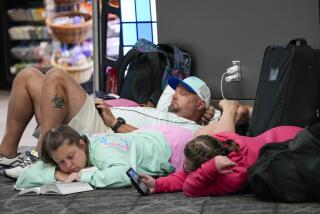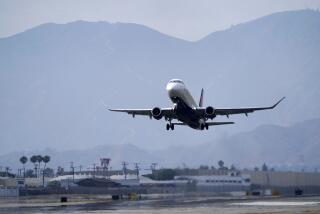Pilot Protest Over Shared Runways May Cause Delays
- Share via
WASHINGTON — An airline pilots union is urging its members to stop taking part in runway-sharing landings that save time, despite winning the postponement of new federal rules governing the procedures.
The pilots’ action could cause delays at major airports over the busy Memorial Day weekend. They contend, however, that federal regulators have failed to meet their concerns about safety.
“We are uncompromising on this issue,” Capt. Dennis Dolan, vice president of the Air Line Pilots Assn., said Thursday.
“The ball is in their court,” added John Mazor, a spokesman for the association, which represents 58,000 pilots at 50 U.S. and Canadian airlines.
The procedure in question, called “land and hold short,” is widely used at major airports. Mazor admitted that busy airports such as Chicago’s O’Hare could be affected by the recommended pilot action.
“It won’t take all that many pilots to throw a monkey wrench into their operations,” he said, adding that pilots have grown frustrated with negotiations on the rules, which were to take effect Saturday.
Airline pilots worried that the rules, intended to further speed up takeoffs and landings, could increase the danger of collisions on the ground.
William Shumann, a spokesman for the Federal Aviation Administration, said air-traffic controllers will continue to offer pilots clearances to land and hold short.
Dolan said the union will continue to urge its pilots to decline such offers but is willing to keep working with the FAA and airlines to reach agreement on the procedure.
Dolan also said there are some airports where the FAA should not continue to allow such clearances until the agency completes detailed computer modeling tests of the safety of the procedure in those locations. The FAA plans to perform those tests.
“Our contention is that the procedures as developed are safe. Running additional models will provide greater assurance, but we do not see why we should discontinue a safe procedure until that modeling is done,” Shumann said.
Neither the FAA nor the pilots were immediately able to name the airports in question.
Land and hold short is a procedure in which an arriving pilot is given clearance to land but is asked to stop short of a crossing runway, which is being used for another plane landing or taking off. After the second plane passes, the first pilot can then proceed to the terminal.
A pilot can refuse to hold short, in which case the plane using the cross runway must wait, delaying its arrival or departure.
The procedure has been in use at many large airports for as long as 30 years as a means of speeding up operations.
The changes to take effect Saturday would have added private pilots and foreign airline pilots to those allowed to take part in land-and-hold-short operations. The rules also would have changed the minimum runway distance needed for specific airplanes taking part in such operations.
The pilots objected to the changes in available runway length. They also urged the FAA to make sure that foreign and private pilots understood the procedure and were trained in it before the rules were in place.
More to Read
Inside the business of entertainment
The Wide Shot brings you news, analysis and insights on everything from streaming wars to production — and what it all means for the future.
You may occasionally receive promotional content from the Los Angeles Times.










